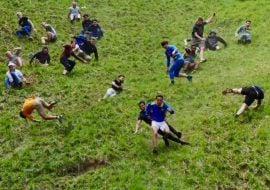Climbing Photography: How Did They Take That Photo Anyway?


On June 3, 2017 Alex Honnold completed his free solo ascent of El Capitan, the first of its kind on the iconic granite face and a milestone in the sport of big wall climbing. It’s quickly becoming customary for these iconic climbs to be accompanied by the future release of video footage, both to silence naysayers and to provide an artistic take on a beautiful feat. Adam Ondra just released a film about his climb Silence — currently the hardest climb in the world; a film for Tommy Caldwell’s Dawn Wall ascent has been in the works for a few years; and a documentary capturing Honnold’s own climb is expected sometime in 2018.
Iconic footage and photographs inevitably lead to questions, though. While the most common question that non-climbers have about climbing is usually,
“How did they get the rope up there anyway?,” the question “But how did they take that photo?” comes in at a close second.
Indeed, this is definitely something worth being puzzled over. If these elite climbers are performing unimaginable feats never-before-seen by human eyes, then how exactly do you explain the photographer that’s hanging out with them on this blank rock face? The people behind the lense of some of the great climbing photos of our time are no less legendary than the men and women who they photograph. Let’s take a look inside the world of climbing photography.
Techniques in Climbing Photography

Photo credit: Jimmy Chin
Climbing photographers use a wide variety of techniques to both get into position for their money shots and capture the shots themselves. Here are a few techniques that a suitably athletic (if not world class in their own right) climber can use to hang with the pros:
Jugging: It goes without saying that climbing up a rope is much easier than climbing up a featureless vertical cliff. For many historic ascents, climbers and photographers will set up a number of ropes before the main event. Although the star of the show may never touch these ropes, photographers can use a technique called jugging to move up and down them. Jugging involves devices called ascenders, which move easily upwards on a rope, but will lock when confronted with downward force, preventing a fall.
Aid Climbing: Honnold’s historic ascent was in a style of climbing called free soloing. The “free” means that Honnold used only his own body to climb — he never pulled on any gear or ropes to make progress on the climb. However, free climbing isn’t the only way to get up a wall. By placing gear in cracks or around naturally occuring horns on a wall of rock, a climber can pull herself through a section of climbing that would otherwise be impossible. This type of climbing, called aid climbing, can allow a photographer to climb above the main event in order to get that perfect shot of history in the making.
However, although many of the great shots in climbing history have been taken with a human eye behind the camera, new techniques can allow photographers to capture images from a safe vantage point on the ground. Here are some examples of technological breakthroughs in climbing photography:
Drones: Drones are revolutionizing the way we do a lot of things, including rock climbing. With traditional climbing techniques, a photographer can only position herself at certain angles relative to the climber. She can never, for example, pull way out from behind the climber and catch a shot of the professional at work on a massive granite canvas. However, with drones these kinds of shots are possible.
Remote Cameras: When Alex Honnold climbed El Capitan for his historic ascent, he knew that a single distraction could send him tumbling down to the valley floor. For this reason, photographers capturing Honnold’s climb placed remote controlled cameras in cracks that could capture some of the most difficult parts of the climb. Without anyone else nearby to distract him, Honnold was able to complete these sections in legendary fashion while photographers were able to come by and collect the cameras later for their footage.
Climbing Photographers as Athletes
Although there are some techniques that allow climbing photographers to keep up with all-stars of the climbing world, those strategies don’t take much of the challenge out of climbing. The very best climbing photographers are athletes in their own right. Keep in mind that a photographer doesn’t just have to carry her own weight up the wall — she also needs to haul all of the cameras, lenses, and other equipment necessary to capture the best shots. Here are some legendary climbing photographers who could also be included in a list of the world’s best climbers:
Jimmy Chin: Jimmy Chin is to climbing photography as Alex Honnold is to climbing at large. So it should come as no surprise that Chin has been the lead photographer on a number of Honnold’s historic climbs, including his free solos of El Capitan and Half Dome. Chin has also made history himself, all while documenting it in the film Meru, which captures Chin’s ascent of a remote Himalayan peak alongside Conrad Anker and Renan Ozturk.
Ken Etzel: Making his home in the climbing mecca of Bishop, California, Ken Etzel is known for his breathtaking alpine shots, which require him to travel across the same steep terrain as the climbers that he captures.
Irene Yee: Women’s representation in rock climbing still needs work, but Irene Yee is working to change that. Irene made her big breakthrough into the world of climbing by posting her own climbing photos to Instagram. Now she collaborates with world class climbers like Kathy Karlo and Matt Farrell.
Unleashing Your Inner Photographer

Photo credit: Ken Etzel
Every famous climber got their start somewhere, and so did every good climbing photographer. It’s possible to either step up your game when it comes to capturing your friends at your local crag or even have your own climbing photos featured in National Geographic one day. Whether you’re looking to improve your Instagram page or you just want to quit your job and travel the world, here are some tips to climb to new heights when it comes to your own climbing photographs:
Take lots of shots. Nobody can predict which snap will become the next iconic climbing photo until it happens. Take shots, even when you don’t think they’ll turn out good, then come back and review your work later. You’ll pick out the real winners at home.
Get used to taking pictures on your phone. These days, camera phones can be just as good as an expensive digital camera in the right hands. With added benefits like compactness and cloud storage, it’s about time to improve your phone photography.
Get a strap! There’s enough choss — loose, fallen rock — at the bottom of any respectable cliff. Whether you use a DSLR camera or just your smartphone, get a strap so that your gear doesn’t end up as choss too!
Climbing photography can be a feat as legendary as historic climbs themselves. The perfect shot is often a combination of athleticism, creativity, and luck.
Related Articles:
What Makes The Most Elite Climbers In The World
Ultimate Guide To Peak Bagging In Idaho’s Mountains
Feature image: Climber Kathy Karlo. Photo credit: Irene Yee
Last updated on Apr 3, 2018Have you subscribed to our Newsletter or Podcast? Listen to us on Apple Podcast and Spotify and follow us on Facebook, Instagram Twitter and YouTube.








